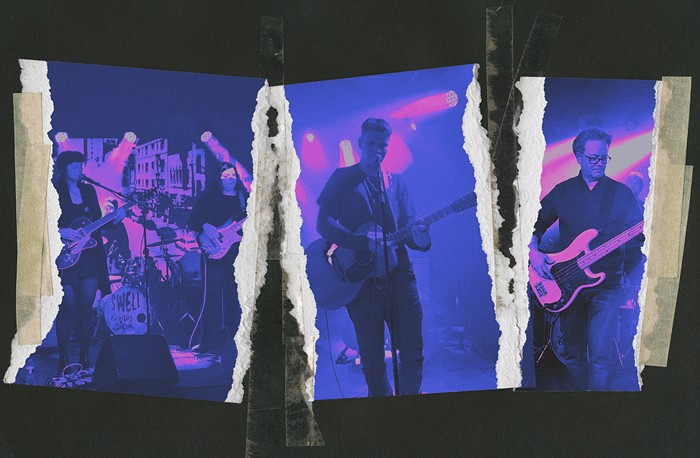This past summer, in the middle of a highly anticipated set from Joanna Newsom that previewed her sprawling, Byzantine, and seemingly unending new compositions, the singer revisited a little song off of her endearing debut, 2004's The Milk-Eyed Mender. Tangentially about her dog, "Sadie" tucked within its hypnotic Lyon & Healy 15 harp plucks a little couplet that doubles to illuminate Newsom's craft as a whole: "And all that I've got and all that I need/I tie in a knot that I lay at your feet." Whether in a four-minute design or—as the majority of that new set manifested itself—waaaaay beyond the 10-minute mark, that method remains unchanged. Newsom still knits and knots variegated threads together, but her scope and scale have evolved, perhaps irrevocably. Forget darning together a quaint little place mat or doily for us a second time around; on Ys (pronounced as "ease"), Newsom knots and plunks nothing less than the Unicorn Tapestries at our feet.
Just in comparing covers, such change is evident. Mender featured a hand-stitched image on the cover with Newsom's picture sewn into the middle; Ys offers a lustrous oil painting. Now she appears as some tower-ensconced princess, distant from the earth, cryptically holding a scythe and a framed moth, evocative of a Renaissance portrait. And while her debut was full of deftly crocheted, homespun tunes, the five titles that make up Ys transcend every notion of "song," suggesting instead classical composition; the verse-chorus-verse is replaced with themes (both lyrical and musical) that digress and disappear, only to return in new transformations over the course of time. Or, put another way, if The Milk-Eyed Mender was a quilt—warm, homey, and intimate—then Ys eschews such cover and comfort altogether, instead baring its listener to the splendor of the night sky. Yes, the stars are heavenly and majestic, but distant from earth and untenable.
Appropriately enough, "Emily," the 12-minute composition that opens Ys, is about gazing up at the firmament with her sister and her pa (who points to the Big Dipper that "leads to a dirt-red bullet of light"), its lyrical center a meme on distinguishing meteors. For all the lazy equations of Newsom's music to fairies, pixies, and fantastical wonderlands (due in no small part to her arcane diction, instrumentation, and her previous freak-folk persona), the imagery is firmly entrenched in the everyday. It's within the mundane that the magical can occur, and Ys's immense space allows for such an unfurling. Between the reiterations in "Emily" that "the meteorite's just what causes the light/and the meteor's how it's perceived," streams a parade of baboons, grouse, midwives, tugboats, butterflies, hydrocephalitic listlessness, asterisms, and ants. Both cosmic formations and tiny bugs are given space to crawl across this canvas.
Helping her to capture both the macro- and microcosmic aspects of her music are an elite cast: Steve Albini recorded her and her harp, while Jim O'Rourke mixed and married the arrangements of Van Dyke Parks to it. Parks—collaborator with Brian Wilson on Smile and creator of Dixieland-Charles Ives soundclashes on his own Song Cycle—twirls strings, woodwinds, banjo, accordion, and kettledrums around that telltale harp. Such orchestration swoons elegantly on certain passages, yet at other times resounds as sentimental or even Disney-fied.
For all the fanfare and orchestrations, the album's peak is the unadorned "Sawdust & Diamonds," consisting of harp and Newsom's singular voice. While her dissidents complained of her tendency toward petulant shrieks and pipsqueaks, like that of an 8-year-old (or else an 80-year-old), here her maturity is evident. Her throat still quivers to reach certain peaks, but rather than break, she opts instead for a more honeyed, wispy tone. Within "Sawdust & Diamonds," the ornate cascades of harp strings accentuate certain aspects of Ys so that they can more readily be gleaned: sparrows, falling rocks, breaking bones, the fragile flesh, and the unseen audience.
There's also an allusion to the heavily constructed nature of the creative act itself, to the chimera of performance, which the odd Aesop fable of "Monkey & Bear" addresses. As the two creatures (who are also lovers) escape from the confines of the circus, ignoring the decree to "stay by the gate... remain in your place," more than physical barriers suppress them. It's not love that dictates their relationship, but rather fear. They fret about hunger, that "they have got to pay the bills." The monkey cajoles the bear "to dance, my darling," to continue on with their organ-grinding routine, promising a vague future of satisfaction and love, but the payoff never arrives. Instead, the bear, separated from her lover, sloughs off her coat, that old version of self, undergoing a curious metamorphosis to where at song's end, "bear stepped clear of bear." Rather than trade in escapist fantasy, even on this fable, the core is one rooted in reality and mortality.
It's a change that Newsom would recognize within herself. And yet, while there's a plethora of challenging musical pirouettes to admire on Ys—an artistic bravado on her part to overreach, to escape from the stylistically narrow and fascistic world of "indie rock," to be a wizard, a true star—there's little to embrace. Her sextet setting of the album live reduces and warms it considerably; but on disc, it's grandiose and portentous, with simply too much ornamentation to love Ys outright. The cosmos is admirable and gorgeous to be sure, but ultimately it's a chilly place. 


















